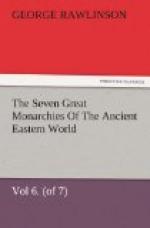The narrative of these events derives its interest, not so much from any sympathy that we can feel with any of the actors in it as from the light which it throws upon the character of the Parthian rule, and the condition of the countries under Parthian government. In the details given we seem once more to trace a near resemblance between the Parthian system and that of the Turks; we seem to see thrown back into the mirror of the past an image of those terrible conflicts and disorders which have passed before our own eyes in Syria and the Lebanon while under acknowledged Turkish sovereignty. The picture has the same features of antipathies of race unsoftened by time and contact, of perpetual feud bursting out into occasional conflict, of undying religious animosities, of strange combinations, of fearful massacres, and of a government looking tamely on, and allowing things for the most part to take their course. We see how utterly the Parthian system failed to blend together or amalgamate the conquered peoples; and not only so, but how impotent it was even to effect the first object of a government, the securing of peace and tranquillity within its borders. If indeed it were necessary to believe that the picture brought before us represented truthfully the normal condition of the people and countries with which it is concerned, we should be forced to conclude that Parthian government was merely another name for anarchy, and that it was only good fortune that preserved the empire from falling to pieces at this early date, within two centuries of its establishment But there is reason to believe that the reign of Artabanus III. represents, not the normal, but an exceptional state of things—a state of things which could only arise in Parthia when the powers of government




